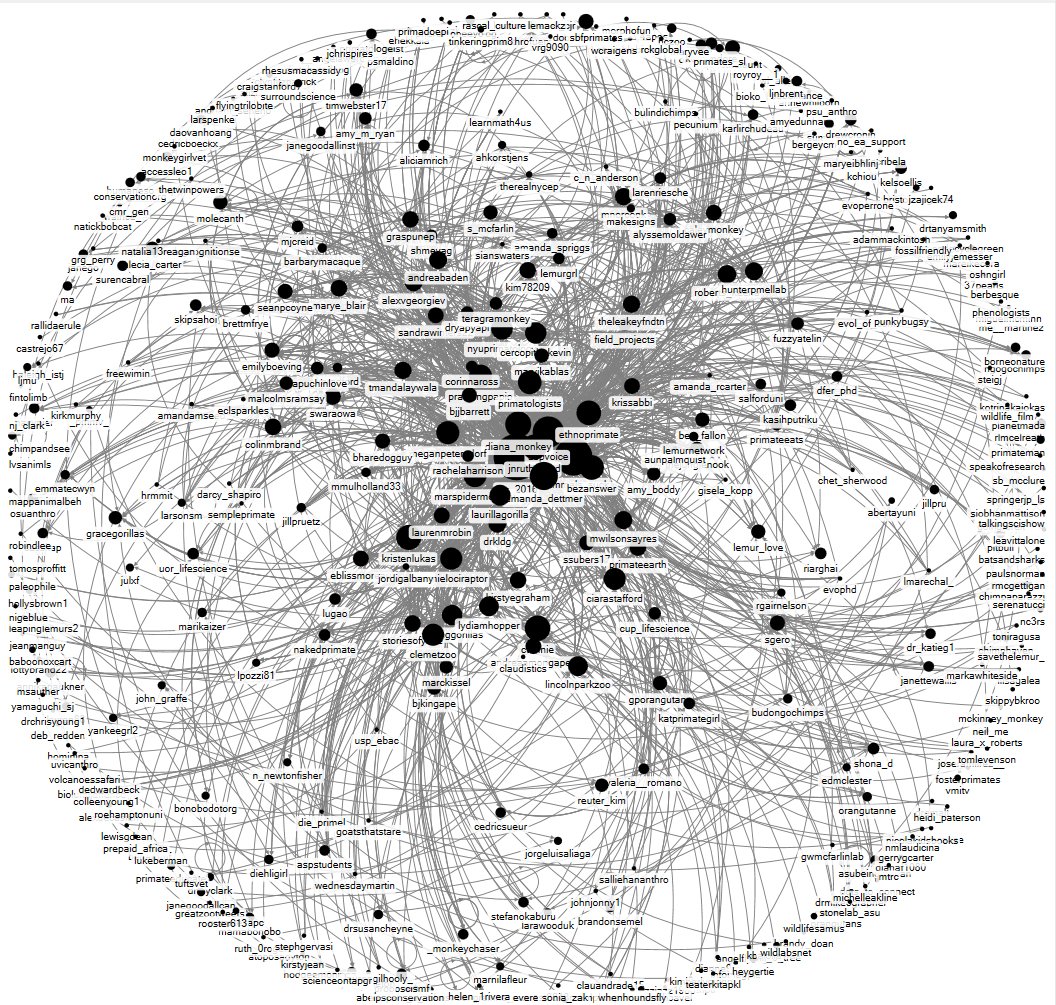This was my first conference in which I live-tweeted, which was a lot of fun! I also got to meet some of my "twitter friends." Whale biologist Shane Gero (who presented in a symposium on the convergence of whales and primates) put together a pretty cool sociogram of the IPS/ASP twitter network.

Shane Gero's awesome sociogram--I'm pretty central!
At Chimps in Context, I presented an e-poster, Socio-behavioral Convergence of Female Affliative Behaviors in Pan and Ateles. Frans de Waal liked it, so I think it was a success :)
Thanks to Alex Georgiev for taking the pic!
At the IPS/ASP meetings, I had a podium presentation on Grooming Networks in Captive Chimpanzees and Bonobos.
Thanks to my co-author Emily Boeving for taking the pic!
Here are some of my big take-aways from both meetings:
- Spider monkeys and bonobos are my true loves
- Comparative research between species yields the most interesting findings (which is why I keep moving on to different species!)
- Female bonobos reach puberty WAY earlier than female chimpanzees, and immigrate earlier, but reproduce at the same age--what's going on?
- Geoffroy's spider monkeys (Ateles geoffroyi) have joined the Top 25 most endangered primates, and this breaks my heart :(
- There's a site where female spider monkeys form linear dominance hierarchies, which is CRAZY! It's likely due to habitat degradation that is forcing them into more contest competition
- Several spider monkey researchers (including myself), are highlighting the amazing convergence between spider monkeys (Ateles) and chimps/bonobos (Pan)--but we really need to get the chimp and bonobo researchers on board!
- Chimp research is still largely dominated by a few East African chimp sites--which is a shame because there are some great central and western chimpanzees sites (including Fongoli)!
- Researchers studying other primates are frustrated with constantly being told that they should be studying chimps or that their research is less important/interesting/meaningful/relevant because it's not chimpanzees
- This is particularly annoying because from my past interview experiences, if you want to study chimpanzees after studying other primates, it's seriously questioned why you are interested in them/if you are sufficiently qualified to study chimpanzees
- live-tweeting can really run your phone battery down--so it's a good idea to bring your charger, and tweet selectively!
- I had lots of close encounters with Jane Goodall, but when I was introduced to her I said "hi," shook her hand... and silence. I could have told her what I study, or asked for a picture, instead... awkward silence, Ooops.
- My major fangirl moment was seeing Karen Strier talking to Jane Goodall!
- Several friends mentioned really horrible field experiences--no one really talked about them in detail, but it's a lot more common than I'd thought.
- My tattoo is gorgeous, and Stephen Nash is proud that I'm the second person to get a tattoo of his artwork... but it was not a strong contender in the tattoo contest. I just can't compete with the full-color ones!
- Primatologists have very mixed results when you tell them you are studying humans
- There's still a lot of disagreement on the ethics of keeping primates in laboratory settings, welfare in captive settings across the board, and the retirement of lab primates to sanctuaries--and it's a VERY tense subject
- The job market for primatologists REALLY sucks--and while it's bad for all of us swimming in a small, dried-up pool, it's also very concerning for the endangered primates who really need us
- While primatology is a female-dominated discipline, seeveral friends and I had a few experiences that reminded us that it sexism is still an issue in our discipline
- 10 days of conferencing is an endurance event, and there are a ton of talks/sessions I wanted to go do, but food, sleep, socializing, and recharging (my brain, my phone, and my laptop) won out.
- IPS 2018 is in Nairobi, Kenya, and IPS 2020 is in Quito, Ecuador! Since I've been dying to go to South America for pretty much forever, I'm hoping to head to Quito in four years.
- As great it is to talk about and learn about primates, it's always fun to ditch out on part of a conference to watch primates.
Macaques at Lincoln Park Zoo during Chimps in Context



